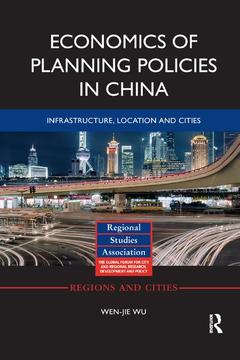Economics of Planning Policies in China Infrastructure, Location and Cities Regions and Cities Series
Auteur : Wu Wen-jie

Fast urbanizing countries like China have experienced rapid ? albeit geographically uneven ? local and regional economic growth during the past few decades. Notwithstanding this development pattern, China has been investing heavily in targeted coastal and inland regions through planning policies for infrastructure, location and cities. This is a largely place-based investment process that is of great importance for the public, business and policymakers. China?s urban and regional transformations provide incentives for spatial agglomeration and will shift the growth of activities within and across cities for decades to come. This spatial differentiation is likely to be driven by government decisions at all levels about where, when and in what to invest, in an institutional context where policy instruments act to constrain or facilitate China?s urban and regional development.
Economics of Planning Policies in China looks at the role that the institutional characteristics of the Chinese planning system and market mechanisms play in transforming and shaping the infrastructure, location and cities with the potential for spatial disparity and inclusive growth. The planning and geographical perspective and evidence make this book a reference for international scholars, policymakers and graduates
List of figures
List of tables
Foreword I by Professor Paul Cheshire
Foreword II by Professor Siqi Zheng
Acknowledgements
PART I Overview
1 Introduction
2 Fundamentals of China’s planning policies
PART II Spatial evolution of planning policies in China
3 Planning for spatial development in the post-war era
4 Planning for transformation: spatial economic prosperity and disparity
5 Planning for urban and regional agglomeration
PART III Planning implications: infrastructure, location and cities
6 Dynamics of urban networks: evidence from airport infrastructure expansion
7 Geographical evolution of railway network development
8 Market reform, land development and urban vibrancy
PART IV Conclusions
9 Concluding remarks
Index
Wen-jie Wu is an Associate Professor at Heriot-Watt University, UK.
Date de parution : 12-2019
15.6x23.4 cm
Date de parution : 12-2016
15.6x23.4 cm
Thèmes d’Economics of Planning Policies in China :
Mots-clés :
Chinese Planning System; Chinese Government; Spatial Economic; Planning Policies; Li Ne; Regional Agglomeration; Pe Ci; Transport Infrastructure Expansions; Ta Te; Spatial Disparities; Intra-city Level; Yangtze River; North Eastern Region; Spatial Economic Disparities; Dense; Comparative Locational Advantages; Airport Network; Neoclassical Economic Growth Theories; Airport Cities; Airport Infrastructure Expansion; Edged Towns; Clustering Coefficient; Area Unit Level; Big Data Perspective; 3rd Ring Road
